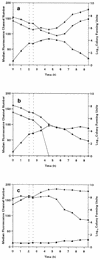Flow cytometric assessment of the postantibiotic effect of methicillin on Staphylococcus aureus
- PMID: 9593149
- PMCID: PMC105776
- DOI: 10.1128/AAC.42.5.1195
Flow cytometric assessment of the postantibiotic effect of methicillin on Staphylococcus aureus
Abstract
The postantibiotic effect (PAE) following a 2-h exposure of Staphylococcus aureus NCTC 6571 to methicillin (5x the MIC) was investigated with fluorescent probes, 5-cyano-2,3-di-4-tolyl tetrazolium chloride (CTC), an indicator of respiratory activity, and the membrane potential-sensitive compound bis-(1,3-dibutylbarbituric acid) trimethine oxonol [DiBAC4(3)]. Counts of the numbers of CFU on solid agar correlated well with information gained from the CTC and DiBAC4(3) fluorescence intensity distributions obtained by flow cytometry and revealed that the postantibiotic effect was 3.1 h. Due to the capacity of flow cytometry to provide information on the heterogeneity of a bacterial population, both fluorescent probes identified the emergence of an active subpopulation 4 h after removal of the methicillin, indicating the recovery of a small percentage of the population. After removal of the methicillin and resuspension of the cells in methicillin-free medium, a further decrease in the respiratory activity and the membrane integrity of the population was observed, although the CFU counts hardly varied, indicating continued antibiotic-induced damage. Also, CTC fluorescence measurements identified numerous subpopulations during the PAE period; this suggests that the PAE is complex, with individual organisms exhibiting various degrees of recovery. Flow cytometry thus provides a rapid and sensitive alternative to traditional techniques that have been used to study PAE, with the added advantage that physiological changes can be detected as they arise.
Figures



Similar articles
-
A flow cytometric study of antibiotic-induced damage and evaluation as a rapid antibiotic susceptibility test for methicillin-resistant Staphylococcus aureus.J Antimicrob Chemother. 1997 Jul;40(1):77-83. doi: 10.1093/jac/40.1.77. J Antimicrob Chemother. 1997. PMID: 9249207
-
Fluorescence monitoring of antibiotic-induced bacterial damage using flow cytometry.Cytometry. 1999 Mar 1;35(3):235-41. doi: 10.1002/(sici)1097-0320(19990301)35:3<235::aid-cyto6>3.0.co;2-0. Cytometry. 1999. PMID: 10082304
-
Rapid assessment of antibiotic effects on Escherichia coli by bis-(1,3-dibutylbarbituric acid) trimethine oxonol and flow cytometry.Antimicrob Agents Chemother. 1997 Sep;41(9):2001-5. doi: 10.1128/AAC.41.9.2001. Antimicrob Agents Chemother. 1997. PMID: 9303401 Free PMC article.
-
[Beta-lactam resistance hits virulence. Methicillin resistant Staphylococcus aureus].Pharm Unserer Zeit. 2006;35(5):422-5. doi: 10.1002/pauz.200600188. Pharm Unserer Zeit. 2006. PMID: 17009786 Review. German. No abstract available.
-
[Methicillin resistant staphylococci].Antibiot Khimioter. 1998;43(6):29-31. Antibiot Khimioter. 1998. PMID: 9644532 Review. Russian. No abstract available.
Cited by
-
Applications of flow cytometry to clinical microbiology.Clin Microbiol Rev. 2000 Apr;13(2):167-95. doi: 10.1128/CMR.13.2.167. Clin Microbiol Rev. 2000. PMID: 10755996 Free PMC article. Review.
-
Bayesian Modeling and Intrabacterial Drug Metabolism Applied to Drug-Resistant Staphylococcus aureus.ACS Infect Dis. 2021 Aug 13;7(8):2508-2521. doi: 10.1021/acsinfecdis.1c00265. Epub 2021 Aug 3. ACS Infect Dis. 2021. PMID: 34342426 Free PMC article.
References
-
- Baquero, F., E. Culebras, C. Patron, J. C. Perez-Dias, J. C. Medrano, and M. F. Vicente. 1986. Postantibiotic effect of imipenem on gram-positive and gram-negative microorganisms. J. Antimicrob. Chemother. 18(Suppl. E):47–59. - PubMed
-
- Bigger J W. The bactericidal action of penicillin on Staphylococcus aureus. Ir J Med Sci. 1944;227:533–568.
-
- Bundtzen R W, Gerber A U, Cohn D, Craig W A. Postantibiotic suppression of bacterial growth. J Bacteriol. 1981;58:475–490. - PubMed
-
- Craig W A, Vogelman B S. The postantibiotic effect. Ann Intern Med. 1987;106:900–902. - PubMed
-
- Craig W A, Gudmundsson S. Postantibiotic effect. In: Lorian V, editor. Antibiotics in laboratory medicine. 4th ed. Baltimore, Md: The Williams & Wilkins Co.; 1996. pp. 296–329.
Publication types
MeSH terms
Substances
LinkOut - more resources
Full Text Sources
Molecular Biology Databases
Miscellaneous

